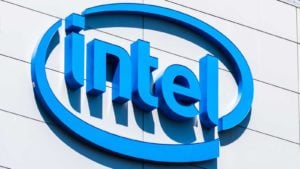Dividend stocks are great ways to beef up your portfolio as long as they’re the right names. You should avoid failing dividend stocks at all costs.
Dividend stocks are often at the core of an investor in retirement because they’re looking for a quarterly or monthly income stream to help supplement their wallets.
Retired investors can’t afford to failing dividend stocks because they usually won’t have the opportunity to return to the workforce and make up for an investing catastrophe.
Failing dividend stocks are a sad state of affairs because that means one of two things – that the payout isn’t worth the falling stock price or weakening fundamentals that put the stock price at risk. Or the dividend itself is in jeopardy.
And what’s the point of having a dividend stock if you can’t rely on a consistent payout?
The Dividend Grader is a great tool to help you weed out failing dividend stocks and secure your portfolio. Here are seven dividend stocks to avoid now.
Intel (INTC)

Chipmaker Intel (NASDAQ:INTC) should be a better stock than it is.
Semiconductor chip makers that are worth their mettle are in the catbird seat as chips remain in high demand for a variety of uses – smartphones, electric vehicles, solar panels and more.
But Intel is struggling and losing market share to competitor Advanced Micro Devices (NYSE:AMD). Analysts expect the company to post an earnings loss in the second quarter. And if it does, it would be the second consecutive loss for Intel.
I’m also uncomfortable with the level of debt that Intel is taking on as it tries to increase its chip-making capacity in Europe.
Intel is spending $33 billion on two chip-making plants in Germany, $4.6 billion on a semiconductor assembly and testing plant in Poland and $25 billion on a microchip factory in Israel.
Intel stock is up 28% this year, but its upcoming capital outlays and a weak dividend of 1.5% are a poor combination for income investors. INTC has a “D” rating in the Portfolio Grader and a “D” rating in the Dividend Grader.
Big Lots (BIG)

Big Lots (NYSE:BIG) is a discount retailer with more than 1,400 locations in the U.S.
The Ohio-based chain offers everything from groceries, furniture, home décor, clothing, and toys.
But the company is having a weak 2023, burdened by inflation, higher interest rates, supply chain issues and lower tax refunds that affected customer spending.
Big Lots reported revenue in the first quarter of $1.12 billion, a drop of 18.3% from a year ago and a net loss of $206.1 million.
That led the company to enact cost-cutting measures, including suspending the quarterly dividend. For dividend investors, that’s a death knell. Why have a dividend stock that isn’t paying a dividend?
Big Lots also announced the sale of 26 locations and a distribution center in California that it says will bring in $310 million in net proceeds.
BIG stock is down 34% in 2023 and has an “F” rating in both the Portfolio Grader and the Dividend Grader.
Johnson & Johnson (JNJ)

You’re surely familiar with Johnson & Johnson (NYSE:JNJ), the famed maker of bandages, health products, cold medications, allergy treatments and cough suppressants.
But what it doesn’t own any longer are some blue-chip brands like Tylenol, Band-Aid and Listerine.
Those products are part of the company’s spin-off of Kenvue (NYSE:KVUE), completed earlier this year.
While JNJ controls over 90% of Kenvue and says the deal will help it refocus on its pharmaceutical and medical device divisions, the market isn’t impressed. JNJ stock is down 10% this year and is in shouting distance of the company’s 52-week low.
Analysts expect revenue of $24.7 billion and EPS of $2.62 when JNJ reports second-quarter earnings on July 20. JNJ offers a 3% dividend yield, but it looks shaky. The stock has a “D” rating in the Portfolio Grader and the Dividend Grader.
Cola-Cola (KO)

Coca-Cola (NYSE:KO) is known for soft drinks, juices, sports drinks, coffee and teas. It has products in more than 200 territories and countries, and its signature red cola cans are iconic.
But sales aren’t so great this year. Yes, revenue rose 4.6% in the first quarter because Coca-Cola raised prices to combat inflation. But sales growth suffered, down 5% in the quarter.
As KO prepares for its second-quarter report, it won’t be able to raise prices again to squeeze more revenue out of its customers.
That’s one reason why the market is a little skeptical of Coca-Cola these days. The stock is down 6% on the year, including about 2% in the last month.
KO announced Q2 earnings on July 26, and analysts are looking for revenue of $11.73 billion and EPS of 71 cents. Anything less than that will be a disappointment.
KO stock offers a 3% dividend yield. It has a “D” rating in the Portfolio Grader and a “C” rating in the Dividend Grader.
Walgreens Boots Alliance (WBA)

Walgreens Boots Alliance (NASDAQ:WBA) has more than 13,000 pharmacy and retail stores across the U.S., Europe and Latin America.
The stock is having a disappointing year, down 18%. Earnings in the fiscal third quarter missed analysts’ expectations for the first time since 2020, as the company brought in EPS of $1 per share versus the $1.07 that analysts expected. Revenue was $35.42 billion.
Walgreens lowered its full-year guidance from a range of $4.45 to $4.65 EPS to a range of $4 to $4.05. It’s blaming its problems on reduced consumer spending and a drop in Covid-19 vaccines and testing.
Walgreens pays a dividend yield of 6.3%, and that appears safe for now. But if Walgreens doesn’t get its fiscal house in order, the generous yield won’t make the stock worth having.
WBA stock has a “D” rating in the Portfolio Grader and a “C” rating in the Dividend Grader.
PacWest Bancorp (PACW)

PacWest Bancorp (NASDAQ:PACW) is a regional bank based in Las Angeles.
It has 67 locations in California and also has a branch in Denver and Durham, North Carolina.
This hasn’t been the year for regional banks. The segment’s been depressed all year following the failures of Silicon Valley Bank, First Republic Bank and Signature Bank (OTCMKTS:SBNY). The three banks held assets of $532 billion and exposed weaknesses in the sector.
Rising inflation took a huge toll on the value of assets for regional banks. And because the sector isn’t as closely regulated as the big banks, it’s more vulnerable to stress and has a harder time repaying depositors who decide to withdraw their money.
PACW stock is down 63% this year, with much of the drop coming in March when the regional bank ugliness first emerged. Earnings in the first quarter were predictably bad, with revenue of $312.6 million and a net loss of $1.2 billion, or $10.22 per share.
PACW also cut its dividend from 25 cents per share to just 1 cent for a yield at today’s stock price of just 0.5%. So it’s no surprise that the stock gets “F” ratings for both the Portfolio Grader and the Dividend Grader.
Paramount Global (PARA)

Paramount Global (NASDAQ:PARA) is a mass media and entertainment company that owns many top properties.
The company was previously known as ViacomCBS, then changed its name to its current incarnation late last year.
The stock is down 2% this year, but that’s after a huge 28% tumble in early May when Paramount’s first-quarter earnings missed estimates and the company whacked the dividend from 24 cents per share to just 5 cents per share.
Revenue for the first quarter came in at $7.27 billion and EPS of 9 cents, versus analysts’ expectations for $7.42 billion and EPS of 17 cents.
While the company’s streaming service, Paramount Plus, added 4.1 million subscribers to reach the 60 million mark, advertising revenue dropped 11%. Overall, the company’s revenue fell 8% on a year-over-year basis.
With its reduced dividend, PARA offers a yield of just 1.2%. It has an “F” rating in the Portfolio Grader and a “D” rating in the Dividend Grader.
On the date of publication, neither Louis Navellier nor the InvestorPlace Research Staff member primarily responsible for this article held (either directly or indirectly) any positions in the securities mentioned in this article.
Financial, Bank, Healthcare, Biotech, Consumer Discretionary, Communications, Media, Retail, Technology, Semiconductor, Streaming
